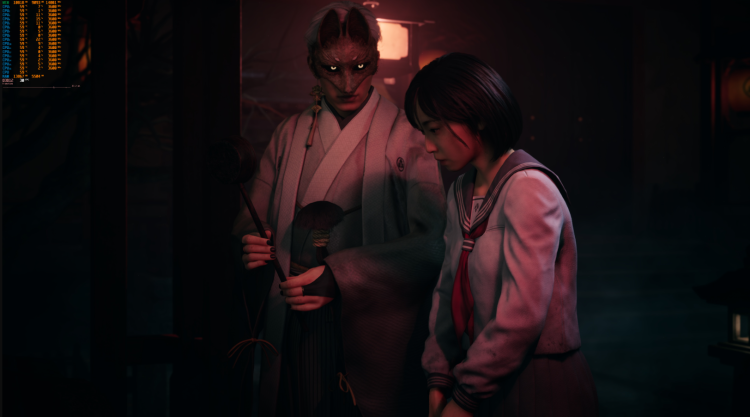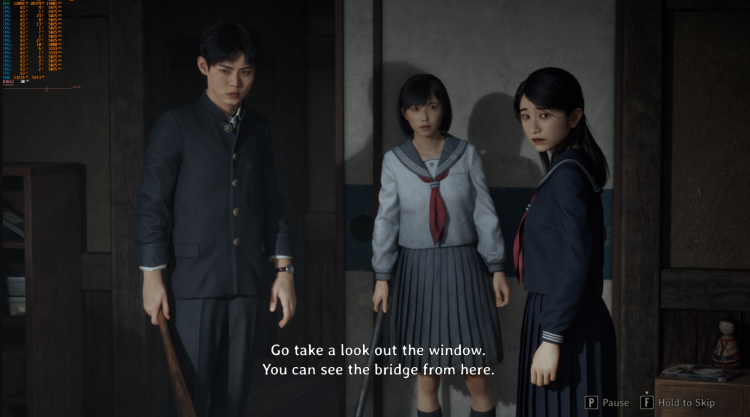True Epic: Slik forbedrer du Silent Hill f-grafikken med skjulte innstillinger
Silent Hill f, Konami’s newest entry in the long-running horror series, is powered by Unreal Engine 5 but initially left many players unimpressed with its visuals. While the foggy atmosphere and dark tone were intact, certain details looked surprisingly flat. It turns out that the developers quietly hid higher-quality settings inside the game’s configuration files. Once unlocked, these “True Epic” settings transform the game’s presentation into something far more impressive.
Unlike most Unreal Engine 5 titles that expose every graphics toggle in the menu, Silent Hill f keeps features like Hardware Lumen and advanced shadow options locked away. By manually creating an Engine.ini file in the AppData\Local\SHf\Saved\Config\Windows folder, it becomes possible to force the game into higher fidelity rendering modes. The required code is long and detailed, but it ensures that every layer of shadows, ambient occlusion, and lighting is rendered at a much higher level.
The difference is immediately noticeable. Vegetation, for example, originally looked flat and underdeveloped. When the hidden settings are activated, proper shadows, depth, and contact lighting make even small plants fit naturally into the environment. Reflections also become more precise with Hardware Lumen enabled, though the main visual boost comes from new shadow and global illumination values.

Image Source: DSOGaming
Of course, there is a cost. Running these hidden options demands far more from your system. On high-end hardware like the NVIDIA RTX 5090, hitting a stable 60 frames per second at native 4K is no longer possible. To compensate, the author of the discovery used DLSS Quality mode to regain smooth performance. Players with less powerful GPUs will have to make further compromises or accept sub-60 performance if they want the full “True Epic” look.

Image Source: DSOGaming
The hidden settings block is extensive, tweaking every aspect of Unreal Engine 5’s renderer. From ray-traced reflections to shadow sampling adjustments and subsurface scattering refinements, it’s all there. The developers seem to have left these options in deliberately but disabled them in the menus, likely to avoid complaints from players who might experience poor performance. Thanks to DSOGaming and MxBenchmarkPC, we know that players won’t see them in the in-game settings, but editing a specific file reveals them.
Here's how to improve Silent Hill f graphics with True Epic visuals settings:
- r.Lumen.HardwareRayTracing=1
- r.Lumen.Reflections.HardwareRayTracing=1
- r.Lumen.ScreenProbeGather.HardwareRayTracing=1
- r.LumenScene.DirectLighting.HardwareRayTracing=1
- r.ContactShadows.OverrideLengthInWS=1
- r.ContactShadows.OverrideLength=25
- r.ContactShadows.OverrideShadowCastingIntensity=1
- r.ContactShadows.OverrideNonShadowCastingIntensity=1
- r.SkylightIntensityMultiplier=0.65
- r.ShadowQuality=5
- r.Shadow.Virtual.ForceOnlyVirtualShadowMaps=0
- r.Shadow.Virtual.ResolutionLodBiasLocal=-2.0
- r.Shadow.Virtual.ResolutionLodBiasLocalMoving=-2.0
- r.Shadow.Virtual.ResolutionLodBiasDirectional=-1.0
- r.Shadow.Virtual.smrt.samplesperraylocal=2
- r.Shadow.Virtual.smrt.samplesperrayhair=2
- r.Shadow.Virtual.smrt.samplesperraydirectional=2
- r.Shadow.Virtual.smrt.texelditherscalelocal=4
- r.Shadow.Virtual.SMRT.TexelDitherScaleDirectional=6
- r.Shadow.Virtual.ScreenRayLength=0.02
- r.Shadow.InsetDownscaleFactor=0
- r.Shadow.PerObjectDirectionalDepthBias=0.5
- r.Shadow.PerObjectDirectionalSlopeDepthBias=3
- r.Shadow.PerObjectSpotLightDepthBias=0.5
- r.Shadow.PerObjectSpotLightSlopeDepthBias=3
- r.Shadow.ShadowMaxSlopeScaleDepthBias=3
- r.Shadow.SpotLightDepthBias=0.5
- r.lumen.tracemeshsdfs=1
- r.Lumen.TraceMeshSDFs.TraceDistance=240
- r.Lumen.ScreenTracingSource=1
- r.Lumen.DiffuseIndirect.SurfaceBias=8
- r.LumenScene.DirectLighting.UpdateFactor=8
- r.LumenScene.Radiosity.UpdateFactor=4
- r.LumenScene.Radiosity.MaxRayIntensity=99
- r.Lumen.ScreenProbeGather.TraceMeshSDFs=0
- r.Lumen.ScreenProbeGather.DownsampleFactor=12
- r.Lumen.ScreenProbeGather.MaxRayIntensity=1
- r.Lumen.ScreenProbeGather.MaxRoughnessToEvaluateRoughSpecular=2
- r.Lumen.ScreenProbeGather.MaxRoughnessToEvaluateRoughSpecularForFoliage=1
- r.Lumen.ScreenProbeGather.ScreenTraces.HZBTraversal.SkipHairHits=0
- r.Lumen.ScreenProbeGather.ScreenTraces.HZBTraversal.SkipFoliageHits=0
- r.Lumen.ScreenProbeGather.ScreenTraces.HZBTraversal.FullResDepth=1
- r.Lumen.ScreenProbeGather.ScreenTraces.HZBTraversal.MaxIterations=30
- r.Lumen.ScreenProbeGather.ScreenTraces.HZBTraversal.RelativeDepthThickness=0.2
- r.Lumen.ScreenProbeGather.ShortRangeAO.ScreenSpace.SlopeCompareToleranceScale=4.0
- r.Lumen.ScreenProbeGather.ShortRangeAO.ScreenSpace.FoliageOcclusionStrength=1.0
- r.Lumen.ScreenProbeGather.ShortRangeAO.MaxMultibounceAlbedo=0.8
- r.Lumen.ScreenProbeGather.ShortRangeAO.ApplyDuringIntegration=0
- r.Lumen.ScreenProbeGather.RadianceCache.ProbeResolution=64
- r.Lumen.ScreenProbeGather.RoughSpecularSamplingMode=1
- r.Lumen.ScreenProbeGather.DiffuseIntegralMethod=0
- r.Lumen.ScreenProbeGather.Temporal.MaxFramesAccumulated=4
- r.Lumen.Reflections.RadianceCache=1
- r.Lumen.Reflections.GGXSamplingBias=0.7
- r.Lumen.Reflections.HierarchicalScreenTraces.MaxIterations=96
- r.Lumen.Reflections.SmoothBias=0.76
- r.Lumen.Reflections.MaxRoughnessToTrace=0.63
- r.Lumen.Reflections.Temporal.MaxFramesAccumulated=0
- r.Lumen.Reflections.DownsampleFactor=0
- r.Lumen.Reflections.HiResSurface=1
- r.Lumen.Reflections.SampleSceneColorAtHit=1
- r.Lumen.Reflections.SpecularScale=0.8
- r.Lumen.TranslucencyVolume.MaxRayIntensity=0.62
- r.Lumen.TranslucencyReflections.FrontLayer.Enable=1
- r.Lumen.TranslucencyReflections.FrontLayer.Allow=1
- r.SSR.Quality=4
- r.SSR.MaxRoughness=1
- r.SSR.Stencil=1
- r.VolumetricFog.GridPixelSize=7
- r.VolumetricFog.GridSizeZ=192
- r.VolumetricFog.UpsampleJitterMultiplier=0.55
- r.VolumetricCloud.EnableLocalLightsSampling=1
- r.VolumetricRenderTarget.Mode=3
- r.SSS.Scale=3.5
- r.SSS.SampleSet=2
- r.SSS.Quality=1
- r.SSS.HalfRes=0
- r.SSS.Filter=1
- r.Water.SingleLayerWater.SupportCloudShadow=1
- r.ParallelShadowsNonWholeScene=1
This kind of tweak recalls the days of Crysis, where max settings pushed PCs to their limits, sparking debate over whether the visuals were worth the performance hit. It seems Konami wanted to avoid those same complaints by hiding them from casual users. For enthusiasts willing to experiment, the rewards are undeniable.
The hidden settings also do not interfere with Silent Hill f’s defining horror atmosphere. Despite some claims in videos that fog may look weaker, closer inspection proves that isn’t the case. The eerie tone remains, but with far more detailed shadows and reflections shaping the world.
On the modding side, experiments with DLSS 4 Multi-Frame Generation have been less positive. Early tests caused major stuttering issues, making it impractical for now. Alternatives like OptiScaler or driver-level frame generation appear to be more stable solutions.
Silent Hill f may not have shipped with its most impressive visuals enabled, but these discoveries show just how much potential lies beneath the surface. For players willing to sacrifice some performance, the game can look closer to a true Unreal Engine 5 showcase than the initial settings suggest.

Kommentarer